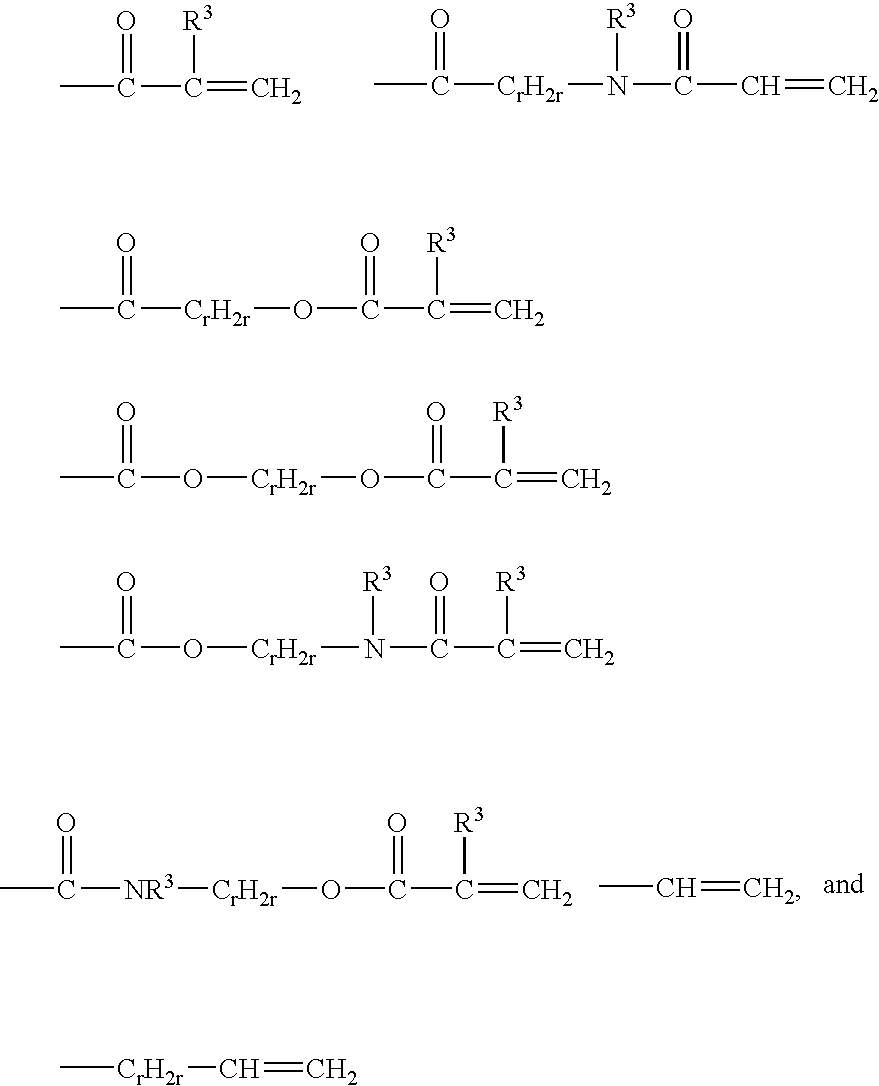Crosslinkable hydrophilic materials from polymers having pendent Michael donor groups
a technology of polymer donor group and crosslinkable hydrophilic material, which is applied in the direction of dyeing process, microcapsule, coating, etc., can solve the problems of ineffective crosslinking gel or solid product, no utilisation or properties of polymer in these articles, etc., and achieve the effect of low residual conten
- Summary
- Abstract
- Description
- Claims
- Application Information
AI Technical Summary
Benefits of technology
Problems solved by technology
Method used
Image
Examples
example 1
Preparative Example 1
Preparation of a Linear Co-polymer of Poly(DMA)-co-(MEAcAc)
[0158]In a glass jar was placed DMA (37.5 grams), MEAcAc (37.5 grams), VAZO 52 (0.3 grams) and 75 grams of THF. The resulting solution was sparged with nitrogen for 20 minutes and then heated in a water shaker bath at 60° C. for approximately 16 hours to allow for polymerization.
examples 1-3
[0159]Examples 1-3 were prepared with various amounts of the co-polymer poly(DMA)-co-(MEAcAc) prepared in Preparative Example 1, MPEG(400)A, PEGDA-1, and THF as shown in Table 1. The components were combined in a glass jar and allowed to form a uniform mixture in a shaker bath at 50° C. for approximately 18 hours. A 1% by weight stock solution of DBU (in THF) was added to the solution and the mixture was stirred with a wooden applicator stick. This mixture was poured onto a Liner and the solvent was allowed to evaporate at room temperature. The transparent films were cured at 70° C. for 7 hours and tested for percent swell using the test method described above. The films remained transparent after swelling.
[0160]
TABLE 1poly(DMA)-co-DBU stock(MEAcAc)MPEG(400)APEGDA-1THFsoln.Example(grams)(grams)(grams)(grams)(grams)% swell14.553.8750.0614.380.6252225.103.8610.0694.380.6249734.912.7880.0664.550.45469
examples 4-6
[0161]Examples 4-6 were prepared with various amounts of the co-polymer poly(DMA)-co-(MEAcAc) prepared in Preparative Example 1, MPEG(400)A, PEGDA-2, and THF as shown in Table 2. The components were combined in a glass jar and allowed to form a uniform mixture in a shaker bath at 50° C. for approximately 18 hours. A 1% by weight stock solution of DBU (in THF) was added to the solution and the mixture was stirred with a wooden applicator stick. This mixture was poured onto a Liner and the solvent was allowed to evaporate at room temperature. The transparent films were cured at 70° C. for 7 hours and tested for percent swell using the test method described above. The films remained transparent after swelling.
[0162]
TABLE 2poly(DMA)-co-DBU stock(MEAcAc)MPEG(400)APEGDA-2THFsoln.Example(grams)(grams)(grams)(grams)(grams)% Swell45.204.4290.0314.290.7154455.514.1710.0334.330.6750865.082.8840.0314.530.47467
PUM
| Property | Measurement | Unit |
|---|---|---|
| viscosity | aaaaa | aaaaa |
| temperatures | aaaaa | aaaaa |
| shrinkage | aaaaa | aaaaa |
Abstract
Description
Claims
Application Information
 Login to View More
Login to View More - R&D
- Intellectual Property
- Life Sciences
- Materials
- Tech Scout
- Unparalleled Data Quality
- Higher Quality Content
- 60% Fewer Hallucinations
Browse by: Latest US Patents, China's latest patents, Technical Efficacy Thesaurus, Application Domain, Technology Topic, Popular Technical Reports.
© 2025 PatSnap. All rights reserved.Legal|Privacy policy|Modern Slavery Act Transparency Statement|Sitemap|About US| Contact US: help@patsnap.com

